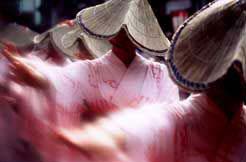ANNUAL CALENDAR August |
|
Nihyaku Toka
|
 A day that rice farmers await nervously in late summer each year is nihyaku toka, which signals the start of the typhoon season. Literally meaning 210 days, it falls on the 210th day after risshun, the beginning of spring on the traditional Japanese calendar. Heavy rainfall and strong winds can wipe out the year's crop if they come before the autumn harvest. In 2000 risshun falls on February 4, and so nihyaku toka is on August 31.
A day that rice farmers await nervously in late summer each year is nihyaku toka, which signals the start of the typhoon season. Literally meaning 210 days, it falls on the 210th day after risshun, the beginning of spring on the traditional Japanese calendar. Heavy rainfall and strong winds can wipe out the year's crop if they come before the autumn harvest. In 2000 risshun falls on February 4, and so nihyaku toka is on August 31.
Nihyaku toka was formally added to the Japanese calendar in 1686 by astronomer Harumi Shibukawa (1639-1715), who was commissioned by the government to revise the official calendar. Waking up one sunny morning, Shibukawa decided to go fishing. But as he was about to set out to sea, the old boatman he had hired warned him that it was the 210th day from risshun. "There's an old saying that the weather always turns stormy on this day." Just as the boatman had cautioned, the morning's clear skies gave way to a thunderstorm by afternoon. Since then, Shibukawa noticed that the few days around nihyaku toka were always stormy, prompting him to mark the 210th day from risshun as an unlucky day on his calendar. Many farming communities developed festivals they hoped would keep the strong gusts on nihyaku toka from destroying their crop. The most famous of these is held in the town of Yatsuo in Toyama Prefecture, in central Japan near the Sea of Japan. Here, local residents dance nearly nonstop for three days and three nights starting on September 1 to invite the evil spirits that create strong winds to join the dancing and forget about causing mischief for a while.
Photo: Dancers try to keep the spirits busy. (Yatsuo Town) |
APR | MAY | JUN | JUL | AUG | SEP | OCT | NOV | DEC | JAN | FEB | MAR |
 |